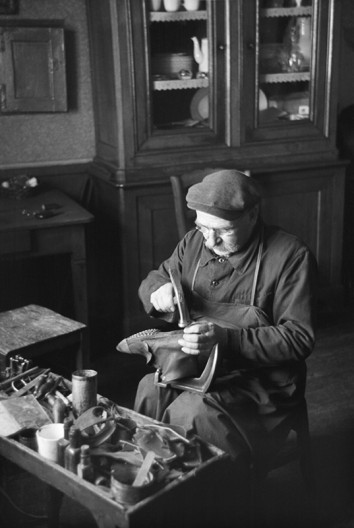Following recent calls for a “history of technology-in-use” (D. Edgerton), “broken-world thinking” (S. Jackson) and a history of technology “after innovation” (A. Russell & L. Vinsel), the international workshop “Histories of Maintenance and Repair” brought together philosophers, anthropologists and historians of technology to discuss the implications of our repair studies, with the aim of better understanding different actor groups through their creative interaction with technology, their maintenance of large technological systems, and beyond. The workshop was organised by the FNR-funded research team “Repairing Technology – Fixing Society. History of Repair in Luxembourg” and took place on 2 and 3 September 2021 in a hybrid format at the Luxembourg Centre for Contemporary and Digital History (C²DH) and online.
Philosophy of Repair
After a short welcome and introduction by STEFAN KREBS (University of Luxembourg), MARK THOMAS YOUNG (University of Bergen) presented his paper on “Technology in Process: Maintenance and the Lives of Artifacts”. He argued that the neglect of maintenance and repair in the social studies of technology could be traced back to ancient Greek philosophy in the concept of substance ontology. This perspective focuses on the becoming and then stable being of man-made objects, and he proposed that this focus on substance might be an important factor in understanding the often discussed problem of the history of technology’s fascination with innovation rather than use and maintenance. If one understands an object to be complete once produced, it is easy to see that researching its becoming is more important than its mundane existence. Yet as it is the latter that historians and philosophers of repair are interested in, Young proposed a shift from substance to process. By defining an object’s nature as constantly in motion, as processual instead of stable, he proposed a (philosophically) grounded case for researching its existence and interconnectedness throughout its entire lifespan.
Maintaining High-Tech (and Power)
The next panel was entitled “Maintaining High-Tech (and Power)”. SANGWOON YOO (Hanbat National University) and LILIANA GIL (The New School) discussed their findings on either end of the spectrum of becoming and being as it was laid out by Mark Thomas Young.
In his presentation “Innovation in Maintenance: Technical Achievements of Cleanroom Operators and Maintainers in Korean Semiconductor Production Lines, 1980s – 2000s”, Sangwoon Yoo presented his insights into what it means to maintain an industrial production infrastructure of semiconductors in South Korea. In presenting cleanrooms, the high demands on technicians in terms of cleanliness and hygiene and the long working hours, he portrayed the field as a high-pressure environment that did not tolerate any serious interruptions in production. While the literature on more mundane maintenance and repair practices focuses on tinkering, workarounds and the importance of tacit knowledge, Yoo presented a series of strict recipes that are continuously engrained into the everyday practices of maintainers. In more than one way it is the story of the undervalued but highly relied upon shop or research assistant, transported into a decidedly high-tech environment.
Liliana Gil then investigated the humdrum of everyday life with readily available technology in her presentation “The Brazilian ‘Electronic Paradise’. Repair Work, Expertise, and Global Connections in Santa Efigênia”. Based on ethnographic fieldwork, she explained that in this field, training in the maintenance and repair of mobile phones involved an unromantic and highly rationalised approach. She was able to show the who, what and why of professional phone repair. Training at the private repair school “Prime” in Santa Efigênia is very structured and goal oriented. By challenging the existing anthropological literature for its romanticised understanding of tacit learning, she focused on the transfer of explicit knowledge in an environment that is neatly set in the neoliberal present. Becoming a phone repair professional promises a steady income for many people in the “Global South”. Yet it is not a creative approach to technology out of need, but rather the task of being rational, quick and clean in repairing people’s phones.
Off the Grid: Everyday Repair Practices
In the third panel, “Off the Grid: Everyday Repair Practices”, KOSTAS LATOUFIS (National Technical University of Athens) and ARISTOTLE TYMPAS (National and Kapodistrian University of Athens), and YOVANNA PINEDA (University of Central Florida) respectively discussed the makeshift repair practices of wind turbines in Scotland and the socio-political environment and implications of farming machines in Argentina.
Kostas Latoufis and Aristotle Tympas took on the story of innovation, or in their words “design knowledge”, through maintenance and repair but focused on the user as the professional. In their presentation, entitled “Makeshift Engineering: Repairing Machines, Crafting Knowledge, and Maintaining Relationships with Locally Manufactured Small Wind Turbines in Scoraig, Scotland”, this practical knowledge stems from day-to-day interactions with these turbines in an extreme (windy) environment that is ideally suited to wind power. When the small settlement of Scoraig, on a remote Scottish peninsula, needed to be electrified in the late 1970s, the community quickly adopted a DIY approach to building their own turbines and spread their knowledge in self-published manuals to anyone interested. This practice, which involves a lot of pride and humour – often expressed in their makeshift style of their maintenance and repair and the community’s understanding of their externally granted expert tinkering status – led to fertile ground for new designs of their own, or for industrial products. By following their story from its humble beginnings to the stage where members of the community were asked to advise leading companies on their work, Latoufis and Tympas showed that it might still be valid to learn from a creative technological engagement as a promising path to knowledge. Even without exoticising and looking for these practices in the “Global South”, where they are often a necessity and not a choice, DIY practices and self-education can be found all over the world, and their results are not to be dismissed.
In the last presentation of the first day, entitled “Gendered Spaces of Repair, Maintenance, and Knowledge Production in Argentina, Twentieth Century”, Yovanna Pineda discussed her fieldwork in South America. Based on her own fieldwork and an abundance of historical sources, her presentation focused on the social hierarchy and relationship of workers and designers in the use and production of combine harvesters, as well as women’s role in this gendered environment. These peoples’ lives all meet around their machinery, its importation into the country, and especially its adaptation to local needs. Instead of researching a top-down process of knowledge transfer, Pineda managed to focus on the detailed processes brought about by the new equipment and the socio-technological shift. In her story, manuals for the machines were rare, and therefore so was the knowledge imbued in them. Bringing many aspects of the other presentations together, she explained how the success of this once foreign and now domesticated machinery was solely based on its users and designers (farmers and blacksmiths) working with them, and thereby gaining an understanding of them. Yet the two groups were not regarded as equal. Where the designers had their workbooks, the users had their laburo – both detailed documents on the machines but with dramatic differences in style and context. Set between these poles, Pineda further discussed the role of women in the field. Although they have traditionally important roles in everyday farm life, their lack of visibility in relation to new technological developments needs to be noted. Yet Pineda’s fieldwork revealed that their role did indeed involve much more than becoming the harvest queen, being shown off with the machines, but that they tended to be administrators and contractors behind the scenes.
Visual Inventory of Repair
On the second day, five papers were presented in three panels. In the first panel entitled “Visual Inventory of Repair”, ANAÏS BLOCH (HEAD, Geneva) started off by presenting “Mobile Repair Cultures: from Informal Repair to Silent Innovation, the Smartphone Case” and spoke about her work on the visual representation of repair cultures in mobile phone repair shops in Switzerland. This allowed an artistic view of the connection between body and (repair) technology. The lecture showed that endogenous, practised repair patterns are a kind of standardisation of repairs, an extension of repair equipment by the body, and at the same time very unique practices that arise from the relationship between technology and people.
Maintaining Infrastructures
On the topic “Maintaining Infrastructures”, LAURA MENEGHELLO (Siegen University), MARTIN MEISKE (Ludwig-Maximilians-University Munich) and AMANDA MCMILLAN LEQUIEU (Drexel University) provided crucial insights into modern and past infrastructures and their interpretations.
Laura Meneghello spoke in her presentation “Between Old and New: Modernizing, Maintaining and Repairing Pneumatic Tube Systems” about the pneumatic mail systems that were introduced from the 19th century onwards in cities and companies, explaining that they were an important, though partially forgotten, element of the communications and transportation infrastructure at the time. Municipal networks were used to send telegrams, letters, documents and small packages through pneumatic tube systems. She showed that smaller pneumatic tube networks were used in factories, hospitals, libraries, offices and administrative buildings to move documents, mail and small items through buildings. Maintaining those networks was a daily task, undertaken in part by specialised personnel and in part by the users themselves, who had to both prevent and correct problems in moving the capsules through the tubes. Secretaries were involved in the maintenance of pneumatic tube networks in offices, as were workers in factories and nurses in hospitals. This maintenance by professionals and non-professional users indicates that infrastructures are themselves a product of constant labour and repair work, in turn creating new work themselves, and that they both shape and are shaped by people.
In his presentation “Cultures and Costs of Maintenance. The Rise of Creosote and its Precarious Legacy”, Martin Meiske examined the impact of creosote and its use as a treatment for wooden railway sleepers, which had to be replaced in regular maintenance cycles. Creosote was used in the railway infrastructure to extend the lifespan of sleepers, so Meiske looked at the long-term effects of railway maintenance using this toxic chemical. While some of the occupational health effects of creosote impregnation did not become apparent until workers had been handling the product for several years, the environmental impacts were severe and unequivocal, especially since creosote was classified as hazardous waste. Nevertheless, the chemical was an inherent part of the infrastructure. As a result of the tightening of environmental regulations in the 1980s, cadastres of contaminated sites were established in several countries. The narrative of creosote thus promised to finally shed light on topics such as recycling and upcycling, and thus on the interaction of people and infrastructure, especially when it comes to problematic substances that are only classified as such over time.
Amanda McMillan Lequieu’s presentation, “Imagining the Unmaintained Object: Industrial Transportation Infrastructure Decline as Narrative Symbol in the American Rust Belt”, explored the narratives of transportation infrastructure decline that enabled a redefinition of deindustrialisation not as a one-time event but as a protracted episode of disinvestment involving specific political and economic actors. She presented the results of nearly 100 interviews and ethnographic and archival research she conducted between 2015 and 2018. She investigated the nodes of a now defunct commodity chain of iron and steel that stretched from a former iron mining district in Wisconsin to a steel mill district in Chicago. The interconnected nature of infrastructure and the fragile landscapes of deindustrialisation drew attention to the fact that material culture is much more than symbolic. These infrastructure problems, as McMillan showed, have material consequences for future development, and they can only be solved by another round of economic and political reinvestment from above.
Maintaining Everyday Repair Opportunities
In the last panel, “Maintaining Everyday Repair Opportunities”, THOMAS HOPPENHEIT and STEFAN KREBS (University of Luxembourg) presented “The Decline of Repair Businesses? Luxembourg’s Repair Sector, 1971-1985”. In their presentation, they showcased the perceived decline of repair services in Luxembourg as a case study for Western consumer societies in the short 20th century. Small repair shops are believed to have long been on the verge of disappearance. But although the 1970s and 1980s are often described as a turning point in the history of repair, Hoppenheit and Krebs stated that repair statistics for Luxembourg do not confirm a decline in repair during this time span. The assumption that repair services should have gradually disappeared and become obsolete during this period because of the availability of cheap consumer goods and the new throwaway culture could not be confirmed. Although official statistics showed a general stagnation and restructuring of the Luxembourg repair sector, the statistical data covered only a fraction of repairers. If one takes into account the statistical exclusion of some repair shops in the 1970s, it can be assumed that repair even gained in economic importance in the 1980s. These data allowed for some interesting observations that argue against the notion of repair as a dying trade.
All in all, the diversity and breadth of the research field was evident in these short two days. The importance of the various histories of maintenance and repair in socio-technical terms was clearly demonstrated. This relatively young field still holds many unexplored corners, black boxes and linguistic encodings. From challenging the history of technology’s understanding of its own scope to learning about very different forms of knowledge transfer (from highly formalised to experimental) and the various expected and surprising human actors that make up networks of maintenance and repair, the workshop offered fertile ground for discussions, while also inspiring some ideas for future research projects.





